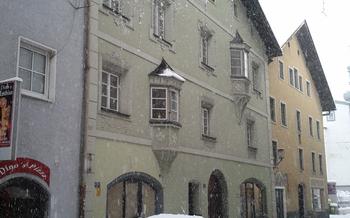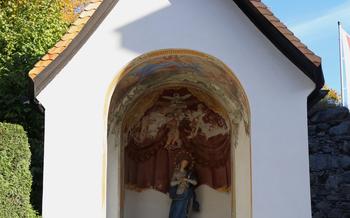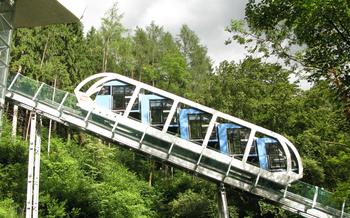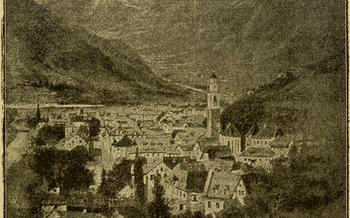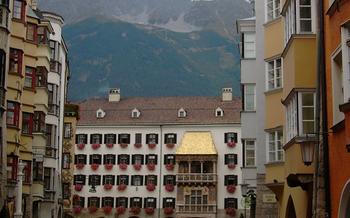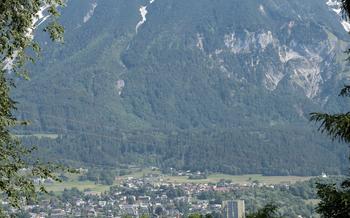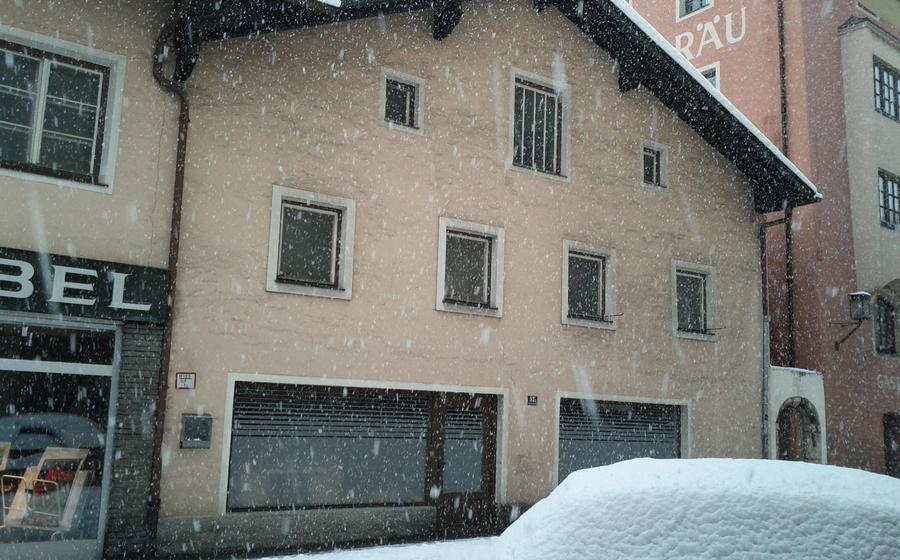
Rosengartenschlucht
- The Rosengartenschlucht: A Natural Wonder
- Planning Your Visit: Essential Information
- Safety First: Guidelines for a Smooth Adventure
- The Devil's Bridge: A Legendary Landmark
- The History of the Gorge: Human Intervention and Nature's Resilience
- Flora and Fauna: Discovering the Gorge's Biodiversity
- Geology and Geomorphology: Unveiling the Gorge's Origins
- Photography and Nature Appreciation: Capturing the Gorge's Beauty
- Guided Tours: Enhancing Your Gorge Adventure
- Self-Guided Exploration: A Journey of Discovery
- Local Cuisine and Culinary Delights
- Nearby Attractions: Exploring the Region
- Insider Tip: Unveiling a Hidden Gem
The Rosengartenschlucht: A Natural Wonder
Nestled in the heart of the Tyrolean Alps, the Rosengartenschlucht gorge is a breathtaking natural wonder that draws visitors from around the world. Carved by the relentless force of water over millions of years, the gorge boasts stunning rock formations, diverse flora and fauna, and a rich history that intertwines with the region's cultural heritage.
The gorge, also known as the Rose Garden Gorge, is a testament to the power of nature's artistry. Its towering cliffs, cascading waterfalls, and lush vegetation create a mesmerizing symphony of colors and textures. The gorge's unique microclimate supports a diverse array of plant and animal species, some of which are found nowhere else in the world.
As a nature reserve, the Rosengartenschlucht plays a crucial role in protecting the region's biodiversity and ecological balance. Its conservation status ensures that future generations can continue to marvel at its natural beauty and appreciate its scientific and educational value.
Planning Your Visit: Essential Information
The Rosengartenschlucht is located in the town of Schwaz, in the Austrian state of Tyrol. It is easily accessible by car, with ample parking available in the vicinity. The gorge is open to the public from April to October, with varying hours depending on the season. Visitors are advised to check the official website or contact the local tourism office for the most up-to-date information.
Guided tours of the gorge are offered by several local companies, providing a wealth of insights into its history, geology, and ecology. These tours typically last for around two hours and are suitable for people of all fitness levels. Visitors can also choose to explore the gorge independently, following a well-marked trail that leads through the narrow passages and over the Devil's Bridge.
The best time to visit the Rosengartenschlucht is during the spring or autumn months when the weather is mild, and the crowds are smaller. However, the gorge is a breathtaking sight in every season, with the lush greenery of summer, the vibrant colors of autumn, and the snow-covered landscapes of winter creating a unique and enchanting experience.
Safety First: Guidelines for a Smooth Adventure
Venturing through the Rosengartenschlucht requires careful consideration of safety measures to ensure a smooth and enjoyable experience. Appropriate footwear with good traction is crucial, as the terrain can be slippery due to moisture and uneven surfaces. Sturdy hiking shoes or boots are highly recommended. Dress in layers to adapt to changing temperatures within the gorge. Carry a raincoat or waterproof jacket in case of rain.
Respect the safety regulations and restrictions implemented for the protection of both visitors and the environment. Stay on designated trails and avoid venturing off the marked paths. Refrain from climbing on rocks or disturbing wildlife. Emergency preparedness is essential. Carry a fully charged mobile phone for communication in case of emergencies. Bring a basic first-aid kit to address minor injuries or discomfort.
Preserving the natural environment is of utmost importance. Avoid littering and dispose of waste responsibly in designated bins. Refrain from picking flowers or plants, as they play a vital role in the gorge's ecosystem. Respect the tranquility of the gorge by maintaining a moderate noise level. Show consideration for other visitors and wildlife by refraining from loud conversations or playing music.
The Devil's Bridge: A Legendary Landmark
A Bridge Steeped in History and Local Legends
The Rosengartenschlucht is home to a captivating landmark that draws visitors from afar: the legendary Devil's Bridge. Its name alone evokes a sense of mystery and intrigue, hinting at the captivating stories and folklore that surround this iconic structure.
According to local legend, the bridge was constructed by the devil himself, who, in a wager with a local farmer, promised to build a bridge across the gorge in exchange for the farmer's soul. The farmer, desperate for a way to transport his goods across the treacherous gorge, reluctantly agreed.
As the devil worked on the bridge, the farmer grew increasingly anxious, fearing for his immortal soul. In a moment of desperation, he sought the help of a priest, who sprinkled holy water on the bridge, causing the devil to vanish in a puff of smoke. The bridge remained incomplete, and the farmer's soul was saved.
Whether rooted in truth or not, this tale adds a layer of enchantment to the Devil's Bridge, making it a captivating attraction for visitors seeking a glimpse into the region's rich history and folklore.
The History of the Gorge: Human Intervention and Nature's Resilience
The Rosengartenschlucht has witnessed a rich history marked by human intervention and nature's remarkable ability to adapt and endure. In the early days, the gorge served as a vital transportation route, connecting the villages of Schwaz and Stans. Mining activities also left their mark, with silver and copper extraction shaping the gorge's landscape. As tourism began to flourish, the gorge's natural beauty attracted visitors from near and far, leading to the construction of trails and bridges for easier access.
Despite human intervention, nature has remained resilient, reclaiming its space and showcasing its regenerative power. Conservation efforts and ecological restoration projects have been instrumental in preserving the gorge's delicate ecosystem. Balancing human interaction with natural preservation has been a continuous challenge, with the aim of protecting the gorge's unique features while allowing visitors to appreciate its splendor responsibly.
Flora and Fauna: Discovering the Gorge's Biodiversity
The Rosengartenschlucht is home to a rich and diverse array of plant and animal life. The gorge's unique microclimate, characterized by humidity and shade, creates an ideal habitat for a variety of species, some of which are rare and endangered.
The gorge's flora is particularly diverse, with over 500 species of plants identified. These include a variety of ferns, mosses, and wildflowers, many of which are adapted to the gorge's specific conditions. One of the most notable plants is the Rosengartenklee, a rare type of clover that is only found in a few locations in the Alps.
The gorge is also home to a variety of animal life, including insects, birds, and amphibians. The most common birds are dippers, which are small, brown birds that are well-adapted to the gorge's fast-flowing waters. Other birds that can be seen in the gorge include ravens, kestrels, and owls. The gorge is also home to a variety of amphibians, including frogs, toads, and salamanders.
The Rosengartenschlucht's biodiversity is an important part of its natural heritage. The gorge provides a habitat for a variety of species, some of which are rare and endangered. Conservation efforts are underway to protect the gorge's flora and fauna and to ensure that this unique ecosystem continues to thrive.
Geology and Geomorphology: Unveiling the Gorge's Origins
The Rosengartenschlucht owes its existence to the relentless forces of nature, primarily glacial erosion and water's continuous sculpting. Over millions of years, glaciers carved their way through the landscape, creating a deep ravine. As the glaciers retreated, water took over, eroding the rock further and shaping the gorge's distinctive features.
The gorge's rock composition also played a crucial role in its formation. Composed primarily of limestone and dolomite, the rock is prone to dissolution by water, leading to the creation of sinkholes, caves, and other karst features. These geological processes have resulted in the gorge's unique and captivating landscape, characterized by steep cliffs, towering rock formations, and hidden chambers.
One of the most remarkable geological features of the Rosengartenschlucht is the Devil's Bridge, a natural rock arch that spans the gorge. Formed by the collapse of a cave roof, the bridge is a testament to the power of water and erosion. It stands as a symbol of the gorge's dynamic geological history and adds to its allure as a natural wonder.
The ongoing geological processes within the Rosengartenschlucht ensure that it remains a living landscape. Erosion continues to shape the gorge's features, and new discoveries are constantly being made. This dynamic environment provides a fascinating glimpse into the Earth's geological forces and the ever-changing nature of our planet.
Photography and Nature Appreciation: Capturing the Gorge's Beauty
The Rosengartenschlucht is a photographer's paradise, offering a stunning backdrop for capturing nature's wonders. To make the most of your photographic adventure, consider the following tips:
-
Choose the right equipment: A wide-angle lens is essential for capturing the gorge's grandeur, while a tripod will help stabilize your camera for sharp images, especially in low-light conditions.
-
Timing is everything: Early mornings and late afternoons provide the best lighting conditions, as the sun's golden rays illuminate the gorge's rock formations and waterfalls.
-
Experiment with different angles: Don't just shoot from the main path; venture off to find unique perspectives and capture the gorge's hidden beauty.
-
Respect nature and other visitors: Be mindful of your impact on the environment and avoid disturbing wildlife. Also, be courteous of other visitors and avoid blocking their views.
-
Share your images responsibly: When sharing your photographs online, remember to credit the Rosengartenschlucht and tag the location to help promote this natural wonder to others.
Guided Tours: Enhancing Your Gorge Adventure
Venturing through the Rosengartenschlucht with a knowledgeable guide offers a wealth of benefits. Guided tours provide insightful commentary on the gorge's history, geology, and ecology, allowing you to delve deeper into its captivating story. Experienced guides lead you through the gorge's intricate paths, pointing out hidden gems and sharing intriguing anecdotes.
When selecting a tour operator, seek reputable companies with a proven track record and small group sizes for a personalized experience. Consider the tour's duration, level of difficulty, and any special interests you may have. Advance booking is recommended, especially during peak season, to secure your spot.
During the tour, actively engage with your guide, asking questions and seeking clarification. Embrace the opportunity to learn about the gorge's unique flora and fauna, the challenges of gorge conservation, and the enduring legends that surround this natural wonder.
Remember, while guided tours offer valuable insights, they may limit your freedom to explore at your own pace. For a more independent experience, consider self-guided exploration.
Self-Guided Exploration: A Journey of Discovery
For those who prefer to forge their own path, self-guided exploration of the Rosengartenschlucht offers a unique and fulfilling experience. The gorge's well-maintained trails are clearly marked, allowing visitors to navigate safely and at their own pace. Embarking on a self-guided journey provides the freedom to linger at points of interest, soak in the tranquility of the surroundings, and connect with nature on a deeper level.
Before setting out, it's essential to plan your route carefully. Consult maps and guidebooks to determine the length and difficulty of the trail you wish to undertake. Pack all necessary supplies, including sturdy hiking shoes, comfortable clothing, a raincoat, and sufficient water and snacks. A flashlight or headlamp may also come in handy for exploring the gorge's dimly lit passages.
As you navigate the gorge's trails, be mindful of safety regulations and restrictions. Stay on designated paths, and avoid venturing into areas that are closed off or deemed hazardous. Keep a respectful distance from wildlife, and refrain from disturbing the delicate ecosystem.
Self-guided exploration allows you to immerse yourself fully in the gorge's beauty and tranquility. Take your time to admire the towering rock formations, cascading waterfalls, and lush vegetation. Listen to the soothing sounds of the rushing water and the birdsong that fills the air. Embrace the opportunity to connect with nature on a personal level and create lasting memories of your adventure in the Rosengartenschlucht.
Local Cuisine and Culinary Delights
When exploring the Rosengartenschlucht, take a break to savor the region's culinary delights. Schwaz offers a diverse range of restaurants and cafes where you can indulge in traditional Tyrolean cuisine while enjoying panoramic views of the gorge. Sample hearty dishes such as Käsespätzle (cheese noodles), Tiroler Gröstl (fried potatoes with meat), or Knödel (dumplings). Don't miss the chance to try local specialties made with fresh, regional ingredients, such as Tyrolean bacon, mountain cheese, and wild mushrooms. For a unique dining experience, pack a picnic and find a secluded spot within the gorge to enjoy your meal amidst the stunning scenery.
Nearby Attractions: Exploring the Region
The Rosengartenschlucht is just one of many natural wonders and cultural landmarks in the region. For those seeking further exploration, here are some nearby attractions worth considering:
-
Swarovski Crystal Worlds: Located in nearby Wattens, this museum and art installation showcases the world-renowned Swarovski crystals through interactive exhibits and stunning crystal creations.
-
Ambras Castle: Perched on a hill overlooking Innsbruck, this Renaissance castle houses a vast collection of armor, art, and historical artifacts, offering a glimpse into the region's rich past.
-
Hofburg Innsbruck: The former imperial palace of the Habsburg dynasty, Hofburg Innsbruck is a magnificent architectural complex with opulent state rooms, museums, and beautiful gardens.
-
Nordkette Mountains: For those who love the outdoors, the Nordkette Mountains offer a stunning backdrop for hiking, biking, and skiing, with breathtaking views of the surrounding landscape.
-
Hall in Tirol: A charming medieval town just a short drive from Schwaz, Hall in Tirol boasts well-preserved historic buildings, picturesque streets, and the Münze Hall, a former mint that now houses a museum.
These nearby attractions provide a diverse range of experiences, from cultural immersion to outdoor adventures, ensuring that visitors to the region have plenty to explore beyond the Rosengartenschlucht.
Insider Tip: Unveiling a Hidden Gem
Beyond the main attractions of the Rosengartenschlucht, there are hidden gems waiting to be discovered. For those seeking tranquility and a deeper connection with nature, venturing off the beaten path is highly recommended. Here are some insider tips to unlock the gorge's secrets:
-
Secluded Spots for Serenity: Explore the gorge's lesser-known nooks and crannies, where you can find tranquil spots to rest, meditate, or simply soak in the beauty of your surroundings. Look for secluded benches or clearings along the trails where you can pause and immerse yourself in the gorge's peaceful ambiance.
-
Off-the-Beaten-Path Viewpoints: Discover breathtaking viewpoints that offer unique perspectives of the gorge. Venture beyond the main viewing platforms and explore the side trails that lead to hidden overlooks. These secret spots often provide stunning panoramas of the gorge's towering cliffs, cascading waterfalls, and lush greenery.
-
Hidden Waterfalls and Natural Pools: Keep an eye out for hidden waterfalls and natural pools tucked away within the gorge. These secluded gems offer a refreshing respite from the hike and a chance to connect with the gorge's water features. Take a moment to admire the cascading waters, dip your toes in the cool pools, or simply relax and listen to the soothing sounds of nature.
-
Avoiding Crowds and Finding Solitude: To truly experience the tranquility of the gorge, consider visiting during off-peak hours or on weekdays. Early mornings and late afternoons often offer a more intimate experience, with fewer crowds and a greater sense of solitude. Embracing the quiet moments in the gorge allows for a deeper appreciation of its natural beauty and a chance to connect with its spiritual essence.
